The Colorado Department of Transportation (CDOT) has issued a request for proposals to plan a commuter-rail line from Ft. Collins to Pueblo, a population corridor just east of the mountains known as the Front Range. CDOT estimates building this line would cost between $5 billion and $15 billion, depending on speed. The agency expects to build all-new tracks within the existing BNSF and UP rights of way, which it says the railroads are willing to allow.
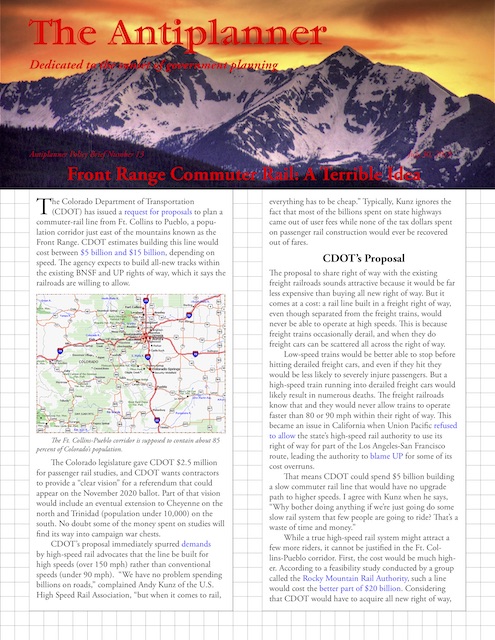 Click image to download a four-page PDF of this policy brief.
Click image to download a four-page PDF of this policy brief.
The Colorado legislature gave CDOT $2.5 million for passenger rail studies, and CDOT wants contractors to provide a “clear vision” for a referendum that could appear on the November 2020 ballot. Part of that vision would include an eventual extension to Cheyenne on the north and Trinidad (population under 10,000) on the south. No doubt some of the money spent on studies will find its way into campaign war chests.
The Ft. Collins-Pueblo corridor is supposed to contain about 85 percent of Colorado’s population.
CDOT’s proposal immediately spurred demands by high-speed rail advocates that the line be built for high speeds (over 150 mph) rather than conventional speeds (under 90 mph). “We have no problem spending billions on roads,” complained Andy Kunz of the U.S. High Speed Rail Association, “but when it comes to rail, everything has to be cheap.” Typically, Kunz ignores the fact that most of the billions spent on state highways came out of user fees while none of the tax dollars spent on passenger rail construction would ever be recovered out of fares.
CDOT’s Proposal
The proposal to share right of way with the existing freight railroads sounds attractive because it would be far less expensive than buying all new right of way. But it comes at a cost: a rail line built in a freight right of way, even though separated from the freight trains, would never be able to operate at high speeds. This is because freight trains occasionally derail, and when they do freight cars can be scattered all across the right of way.
Low-speed trains would be better able to stop before hitting derailed freight cars, and even if they hit they would be less likely to severely injure passengers. But a high-speed train running into derailed freight cars would likely result in numerous deaths. The freight railroads know that and they would never allow trains to operate faster than 80 or 90 mph within their right of way. This became an issue in California when Union Pacific refused to allow the state’s high-speed rail authority to use its right of way for part of the Los Angeles-San Francisco route, leading the authority to blame UP for some of its cost overruns.
That means CDOT could spend $5 billion building a slow commuter rail line that would have no upgrade path to higher speeds. I agree with Kunz when he says, “Why bother doing anything if we’re just going do some slow rail system that few people are going to ride? That’s a waste of time and money.”
While a true high-speed rail system might attract a few more riders, it cannot be justified in the Ft. Collins-Pueblo corridor. First, the cost would be much higher. According to a feasibility study conducted by a group called the Rocky Mountain Rail Authority, such a line would cost the better part of $20 billion. Considering that CDOT would have to acquire all new right of way, the real cost will no doubt be much higher.
On the demand side, the corridor only has about 4 million people today, and most of them would not be conveniently located near a rail station. By comparison, Amtrak’s Northeast Corridor has more than 35 million residents and the California corridor has close to 20 million, and even in those corridors high-speed rail has questionable value.
As a rule of thumb, economists in Europe say that the social benefits of high-speed rail can justify the costs only if opening year ridership is at least 6 million to 9 million passengers (see page 70). Amtrak’s Acela carries only 3.5 million passengers a year; there is no way that Ft. Collins to Pueblo is going to generate 6 million riders a year. Thus, it seems practically certain that, if CDOT were to build commuter rail along the Front Range, it would operate now and forever at conventional speeds.
Cost Overruns
Considering that CDOT hasn’t even done preliminary engineering work on this idea, all cost projections are likely to be unrealistically low while any ridership projections will be unrealistically high. Based on Denver’s experiences with rail transit, actual costs are likely to be double the first projections while ridership is likely to be half.
Denver West light-rail line: 111 percent cost overrun, 111 percent ridership overestimate. Photo by Jeffrey Beall.
For example, the initial projections by Denver’s Regional Transit District (RTD) for the West light-rail line were that it would cost about $335 million (adjusted for inflation) and carry 29,100 weekday riders in its first year. In fact, it cost $707 million and attracted only 13,800 weekday riders. Both the costs and the ridership projections were off by more than 100 percent. There is no reason to think that CDOT will be more accurate considering that it has even less experience building rail lines than RTD had when it made the West line estimates.
Another RTD route, the Northwest corridor between Longmont and Denver, would become part of CDOT’s Ft. Collins-Denver commuter rail route. Yet costs of this line have risen so much and ridership projections are so low that RTD may never build it. Originally expected to cost about $200 million, the current projections are over $700 million and RTD’s own projections of the cost per rider have risen from $16 to $60.
Utah’s Experience
Utah’s FrontRunner: high cost, low ridership. Photo by Paul Kimo McGregor.
Colorado need only look next door to see how well a conventional-speed commuter train along the mountain front works. Utah’s FrontRunner train goes between Ogden and Provo, a distance of about 81 miles. The Utah Transit Authority spent $2.4 billion on this line, with the portion north of Salt Lake City opening in 2008 and the southern portion in 2012.
In 2017, it carried an average of less than 17,600 weekday riders, or 8,800 round-trips per weekday. The average trip is 25 miles long for a total of 122 million passenger miles a year. That’s a lot for a transit agency, but since Ogden-Salt Lake-Provo residents drive well over 50 million vehicle miles a day, the commuter trains account for less than 0.4 percent of the region’s passenger travel.
Utah Transit collects average fares of $1.49 per trip, which is dirt cheap for average trips of 25 miles. But the costs of operations and maintenance are well over $10 per trip, which means that fares cover less than 15 percent of those costs. When capital costs are amortized over 30 years, the trains lose more than $30 per trip. This would be enough to buy every daily round-trip rider a new Toyota Prius with all-wheel drive (essential for Utah) every other year as long as the trains operate.
New Mexico’s Experience
New Mexico’s Rail Runner: Lower costs, but miniscule ridership. Photo by Jerry Huddleston.
Colorado’s neighbor to the south also has an unsuccessful experiment with commuter trains. The state’s Rail Runner train goes between Santa Fe, the state capital, and Albuquerque the state’s largest city. The state spent about $385 million starting this line, a lot less than Utah, but it got a lot less in return: only about 1,400 round trips per weekday.
Before the train, the state operated a bus along the same route and charged a $3 fare between Albuquerque and Santa Fe. The bus required 60 minutes to make the 60-mile trip. The train fare today is about $9 and the train requires 100 minutes to make the same trip.
Counting operating and amortized capital costs, the Rail Runner loses $40 per rider. That’s enough to buy each daily round-trip rider a new Toyota Prius every fifteen months.
Other Intercity Commuter Trains
The Trinity Railway Express is a commuter-rail line that connects Dallas with Ft. Worth.. Despite the region’s population of 5.8 million people, the trains carried an average of just 3,700 round trips per weekday in 2017. Counting capital costs, the train lost $44 per rider, enough to give every daily round-trip rider a new Toyota Prius every year.
Tri-Rail is a commuter train that runs between Miami, Ft. Lauderdale, and West Palm Beach, a distance of about 76 miles. With a population of more than 6 million, this is the nation’s fourth-largest urban area. Yet in 2017 it carried only about 7,000 round-trips per weekday at a cost to taxpayers of about $37 per trip, enough to buy each daily round-trip rider a new Prius every eighteen months.
As I’ve previously shown, many other commuter rail lines that have opened in recent years should be considered failures. The Altamont Commuter Express between Stockton and San Jose carried fewer than 2,500 round trips a day in 2017; Orlando’s SunRail 1,700; Minnesota’s North Star 1,400.
Empty seats mean wasted tax dollars. Source: Calculated from the 2017 National Transit Database.
These trains perform especially poorly because transit agencies used big-box transit systems in corridors that have small-box needs. On average, they fill less than 30 percent of their seats. This in turn is because modern urban areas are not suited to commuter rail transit: people are too spread out and few travelers have both their origins and destinations close enough to rail stations to even consider the option.
There is plenty of traffic in the Front Range corridor, especially between Ft. Collins and Denver. But no more than about 2,300 workers commute from Ft. Collins to Denver. Few of them are likely to both live and work near a rail station. So the market for a commuter train is very limited.
With more than 175 miles separating Ft. Collins from Pueblo, Colorado’s Front Range population is much more spread out than in the Miami area. Miami-Ft. Lauderdale-West Palm Beach populations hug the coast line at an average density of 4,900 people per square mile. The density of the Denver urban area is only 4,000 people per square mile, and the other urban areas along the Front Range average around 3,000 people per square mile. If a commuter train doesn’t work in south Florida, it’s not going to work along Colorado’s Front Range.
The Idiotic Induced Demand Argument
StreetsBlog makes the absurd argument that Colorado should run trains that will be nearly empty because the alternative of building roads doesn’t work: new roads get “filled back up with cars in less than five years.” This is the old “induced demand” claim, but there is no such thing as induced demand. If there were, then roads in rural Colorado would be as congested as interstates 25 and 70 near downtown Denver. Having just returned from a trip through Colorado, I can assure you that they aren’t.
What’s really happening is that congestion suppresses economic activity. Relieving congestion allows that economic activity to increase, which increases urban productivity and wealth. Having roads fill up in five years is a sign of success, not failure.
Regardless of the cause of increased traffic, how sensible is an argument that says the government should build things that people don’t want rather than things they do want? According to this argument, Edison should have made a better whale-oil lamp rather than an electric light bulb; Ford should have made horse-drawn carriages rather than the Model T; and Apple should have made Blackberries instead of iPhones. Only government planners would think that empty trains are a better idea than full freeways.
Environmental Costs
Rail advocates inevitably resort to the claim that trains are environmentally superior to driving. But most of the intercity commuter trains that are similar to a Front Range route use as much, if not more, energy and emit as much greenhouse gases per passenger mile as an SUV or other light truck. Only the Utah train is comparable to the average car.
When the capital costs—that is, the environmental costs of construction—are considered, trains are far worse than highways. Being heavily used by cars, trucks, and buses, the environmental costs of highway construction are spread out among many more users. But a rail line exclusively built for passengers, as the Colorado line would be, would have extremely high construction costs per passenger.
Most of the other commuter lines mentioned here perform even worse than the ones shown in this chart. Source: Calculated from the 2017 National Transit Database.
Partly because Oregon gets most of its electricity from hydroelectric dams or other non-polluting sources, Portland’s light-rail is one of the few rail lines that is energy efficient from an operating view. But, as the Cascade Policy Institute’s John Charles points out, the energy cost of constructing rail is so great that it would take 61 years of operational savings to make up for that cost—and by that time the rail operator would have spent much more energy rebuilding the line twice.
Buses Only Work If Seats Are Filled
Buses would lose less money than trains. In fact, the state of Colorado already offersa money-losing bus service between Ft. Collins and Pueblo. But buses, like trains, can only work if the seats are filled with paying riders. CDOT claims that its bus revenues cover 53 percent of operating costs (see page 25), but its buses aren’t in the National Transit Database and few other numbers are available about the service.
Ft. Collins proudly offers a new bus-rapid transit service that uses giant, articulated buses capable of holding 93 people. On average, in 2017, they carried 12.9 people, meaning they were more than 85 percent empty. As a result, it used more than 4,300 British thermal units of energy and emitted more than 350 grams of greenhouse gases per passenger mile, making them considerably worse than light trucks. The city’s regular buses, which have only half as many seats, fared no better, carrying an average of 6.9 people and using around 25 percent more energy and emitting around 25 percent more greenhouse gases per passenger mile than the bus-rapid transit line. CDOT’s commuter buses probably don’t do much better.
Ft. Collins MAX buses take up a lot of room on the streets, but carry an average of just 12.9 passengers. Photo by Jeffrey Beall.
In the Ft Collins-Pueblo corridor, CDOT’s buses compete directly with Greyhound, which is unfair to the private company. CDOT would probably be better off giving private bus operators incentives to offer more service in Colorado than to operate its own.
Why Spend Millions Studying a Terrible Idea?
A Front Range commuter train is such a bad idea that it doesn’t even deserve to be studied. CDOT’s request for proposals is based more on ideology than rationality and more on politics than economics. Colorado voters should be wary of promises made about costs, ridership, and congestion relief as the likelihood is that it will cost far more, carry fewer riders, and provide no reductions in congestion.

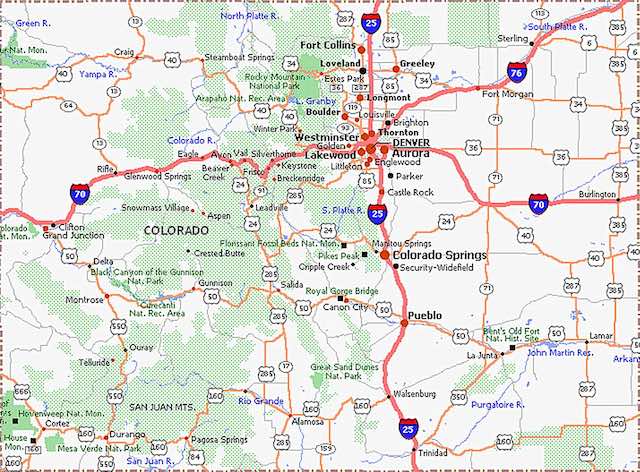
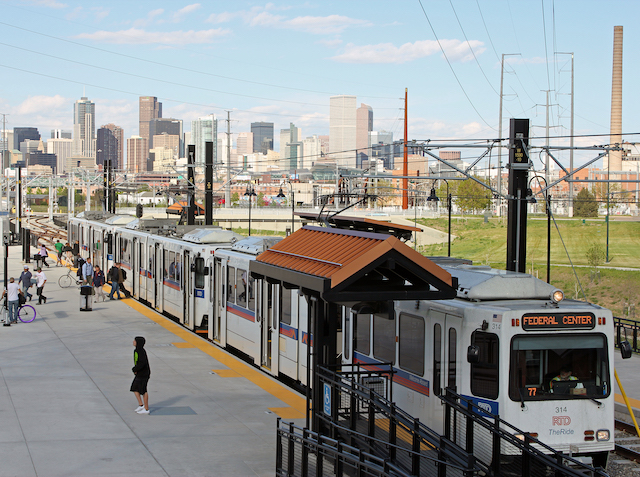

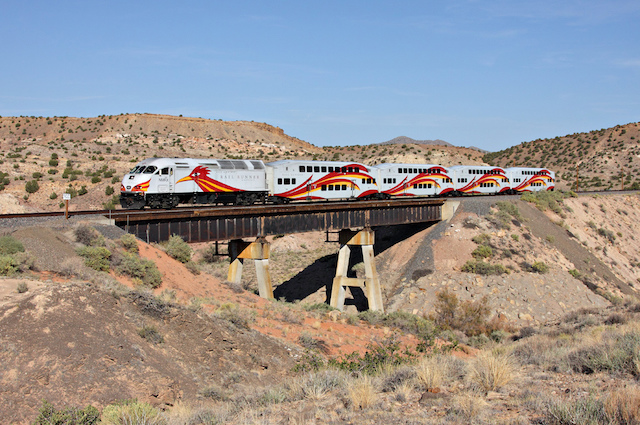


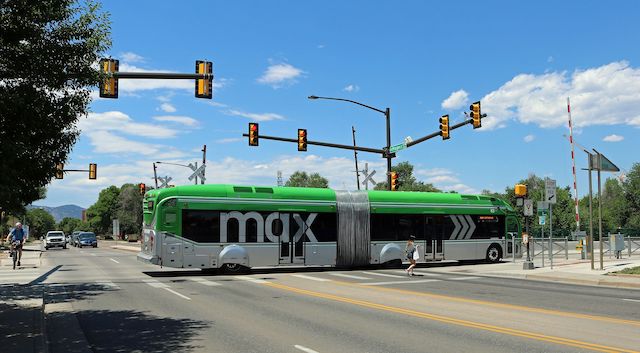







“We have no problem spending billions on roads, when it comes to rail, everything has to be cheap.”
” ~Andy Kunz of the U.S. High Speed Rail Association
@Mr. Kunz, let’s see you say that to the families all the people that died when the 35W bridge collapsed due to design shortcuts to save money.
$20 Billion for a train that’ll serve 1/14th the number of people that the $4 billion Prairie Falcon Parkway would serve.
The technology you use makes a world of difference in costs.
The idea of high speed buses was originally a joke, perpetrated by “the Onion”. However the prospect isn’t a terrible idea. The Superbus is the work of the Delft University of Technology and Prof. Dr. Wubbo J Ockels, a Dutch physicist and astronaut, to provide a realistic alternative to cars and trains. the Superbus looks something like a stretched sports car.
This aerodynamic design enables it to carry 23 passengers at up to 250 km/h, far faster than normal coaches which normally travel at around 100 km/h on highways.
Remarkably, it achieves this using electricity and consumes as much energy as a regular bus traveling at 100km/h thanks to the use of lightweight materials and aerodynamic design shape; provided by Aerospace engineering firm TenCate. If you can streamline normal buses or dedicate lanes to serve their higher speed needs you can vastly undercut rail travel by offering a fast transportation network using pre-existing infrastructure.
So CDOT wants to use funds, given to them by the CO legislature, to pay the project’s contractor to advocate for the project they are planning and building? Doesn’t this strike them as the least bit unethical? It seems to me like a clear conflict of interest.